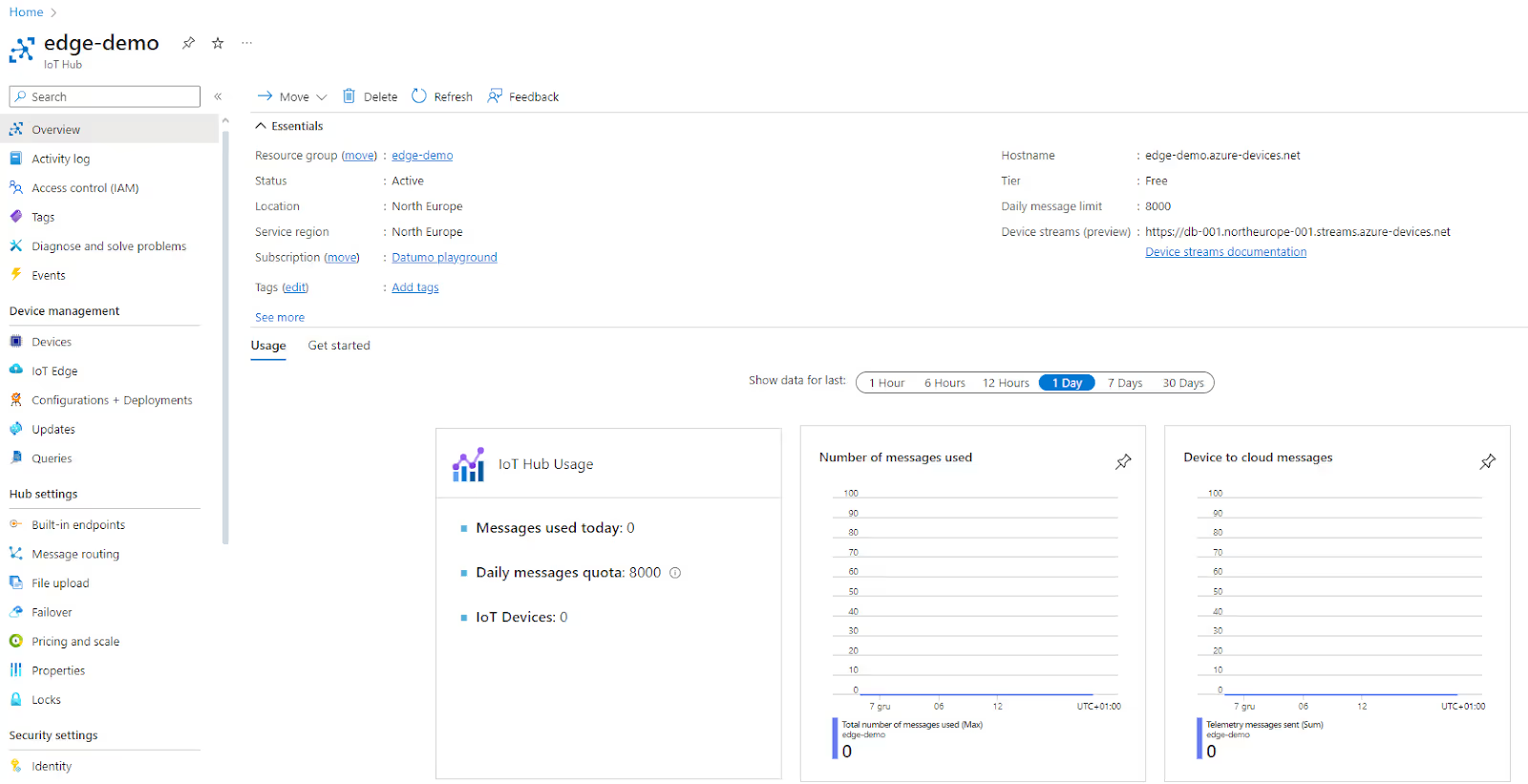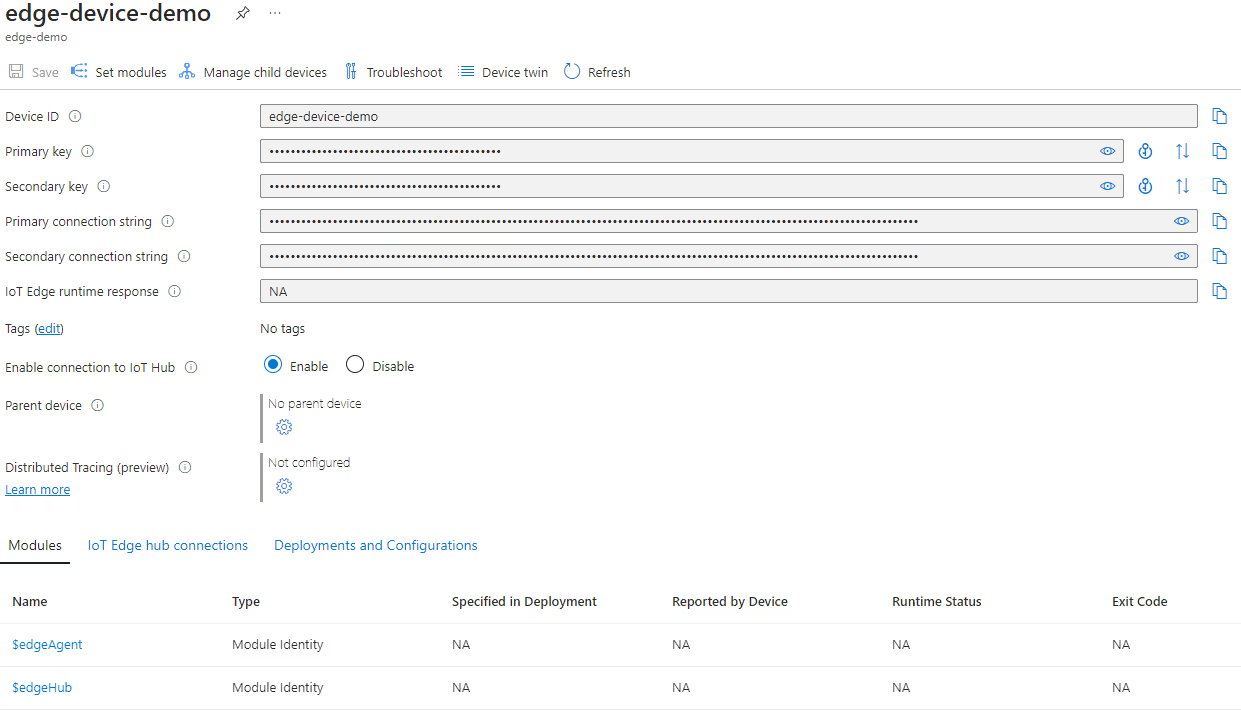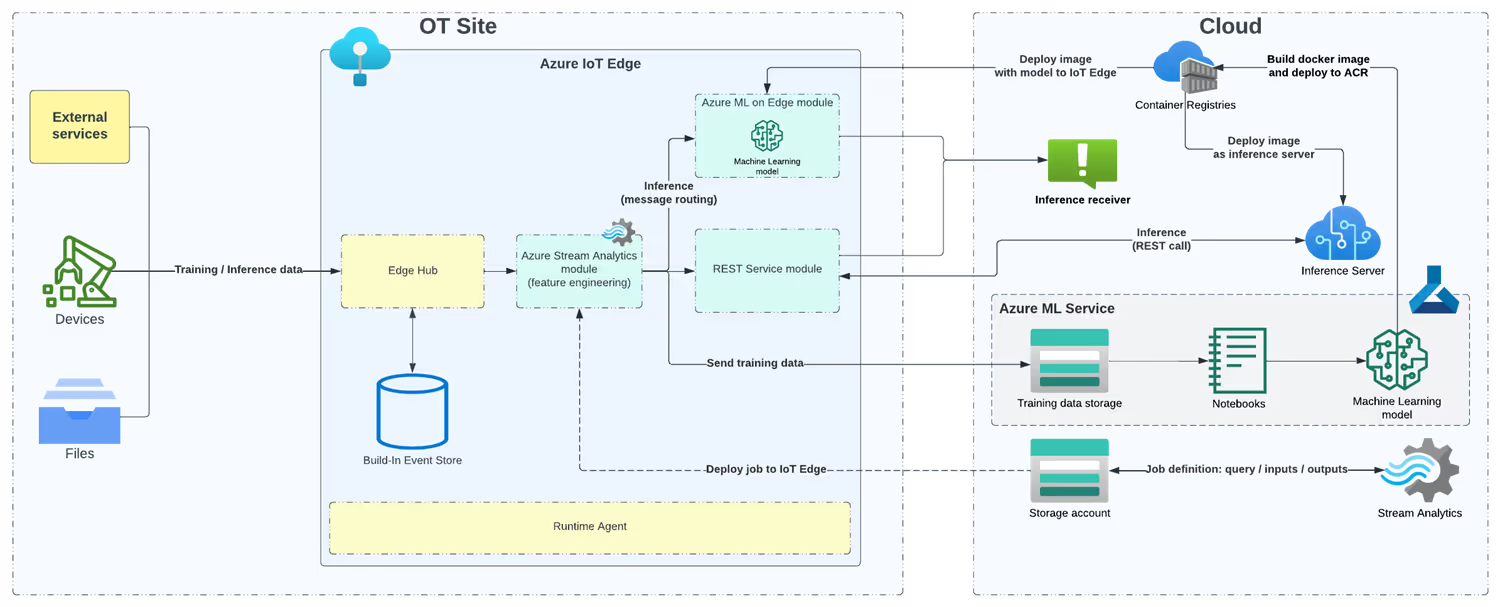Introduction to Azure IoT Edge
In the ever-evolving landscape of the Internet of Things (IoT), the collection, analysis, and utilization of data lie at the heart of innovation and efficiency. With the proliferation of IoT devices across industries, the sheer volume of data generated has become staggering. It is this very data, often referred to as telemetry, that holds the potential to revolutionize decision-making, automation, and operational efficiency across a multitude of sectors.
The pulse of IoT - Telemetry
Telemetry, in the context of IoT, refers to the constant stream of data generated by sensors and devices. This data encompasses a wide range of information, from temperature and humidity readings in a smart home thermostat to the performance metrics of industrial machinery on a factory floor. Telemetry is the lifeblood of IoT systems, enabling organizations to monitor, understand, and respond to the state of their physical assets in real-time.
Traditionally, IoT solutions have relied on centralized cloud-based architectures to process and analyze telemetry data. This approach has its merits, offering scalability and accessibility, but it also has significant limitations, especially when it comes to latency-sensitive applications, privacy concerns, and bandwidth constraints. Transmitting all data to the cloud for processing can lead to delays in decision-making, increased operational costs, and potential privacy risks associated with sensitive data.
To address these challenges, the concept of edge computing emerged. It brings data processing closer to the source of edge data generation, i.e., the IoT device itself or an intermediary device situated closer to it. This approach reduces the latency in data processing and analysis, enabling faster responses to critical events and the ability to operate in low or intermittent connectivity scenarios.
However, implementing data processing directly on IoT devices presents its own set of challenges. Many IoT devices have limited computational resources, making it difficult to run complex analytics or machine learning models locally. Maintenance and updates become cumbersome when dealing with a large number of distributed devices, and security concerns persist.
What is the role of Azure IoT Edge in the IoT ecosystem?
Azure IoT Edge serves as the crucial link in overcoming the challenges of data processing at the edge in IoT. Its a tool for Azure IoT devices and sensors that extends the cloud capabilities and intelligence. This platform offers a practical solution to the intricacies of edge computing.
Azure IoT Edge employs modularization, allowing the deployment and management of code units called modules. These modules can run on IoT devices, gateways, or even in the cloud. They encompass custom code, Azure services, and AI models. Azure IoT Edge handles module orchestration, security, and management, streamlining the deployment and upkeep of edge computing solutions.
In essence, utilizing Azure IoT Edge empowers organizations to exploit the full potential of IoT device telemetry data by processing it in close proximity to its source, all while retaining the adaptability and scalability of the cloud. In the subsequent sections of this article, we will delve further into Azure IoT Edge's architecture, functions, applications, and best practices, illuminating its role in seamlessly integrating edge computing into the IoT ecosystem.
Understanding the concept of Azure IoT Edge
Azure IoT Edge's architecture is a marvel of distributed computing that brings the power of the cloud to the edge of the network. At its core, it offers the capability to process data locally on IoT devices while maintaining a strong connection to Azure services for advanced analytics, monitoring, and management. Let's dive into the key concepts and components that make Azure IoT Edge a versatile and robust solution.
Azure IoT Edge overview

- IoT Edge Device: The IoT Edge Device is any physical device, gateway, or module that runs Azure IoT Edge runtime. It serves as the execution environment for modules and manages the communication with Azure IoT Hub.
- IoT Edge Runtime: This is the heart of the Azure IoT Edge system. It runs on the IoT Edge Device and is responsible for managing the modules, their deployment, and their communication with Azure IoT Hub. It ensures that modules run in isolation from each other, enhancing security and stability.
- Azure IoT Hub: Azure IoT Hub provides bidirectional communication between IoT applications and the devices they manage. It plays a central role in managing and monitoring Azure IoT Edge-deployed devices and modules.
- Azure IoT Edge Module: Modules are units of code that encapsulate specific functionality. Various languages can be used to write an IoT Edge module, including C#, Python, and Node.js. Modules can process IoT Edge data, interact with hardware, or run AI models. Azure IoT Edge supports the deployment of custom modules developed to meet specific application requirements.
- Module Twin: Each module has a twin, which is a JSON document used to store and retrieve desired module configurations and report module state. This twin allows for real-time monitoring and configuration adjustments.
How Azure IoT Edge works
Azure IoT Edge works by deploying modules onto edge devices. These modules process data locally, ensuring low latency and efficient bandwidth utilization. The runtime orchestrates the edge module deployment, communication, and management, ensuring they run smoothly on the device.
The deployment process involves the following steps:
- Module creation: Developers create and package the modules using their preferred programming language and tools. The modules are then containerized using Docker or another containerization technology.
- Module deployment: The modules are deployed to the IoT Edge devices through the Azure IoT Hub. When the device connects to IoT Hub, it automatically downloads any configured IoT Edge module identity. The IoT Edge agent on the device receives the deployment manifest, which contains the exact configurations and desired module states.
- Module execution: The IoT Edge agent ensures that the modules are running as expected on the Azure IoT devices. It monitors the health of the modules and restarts them if necessary. The modules can communicate with each other and with the cloud using the IoT Edge runtime's communication APIs.
Deep Dive into Azure IoT Edge Components
The Azure IoT Edge Runtime is the linchpin of the Azure IoT Edge ecosystem, responsible for managing and orchestrating the deployment and execution of modules on IoT Edge devices. Let's dissect this critical component into its constituent parts and delve into its inner workings.

Exploring the Azure IoT Edge Agent
At the heart of the Azure IoT Edge Runtime is the Edge Agent module. This lightweight component is responsible for edge device management along with the lifecycle of modules. The Edge Agent container is automatically deployed with IoT Edge runtime initialization along with Edge Hub and IoT Edge security daemon. Its primary functions include:
- Module Deployment: The Edge Agent is tasked with deploying modules to the device. It pulls module images from the container registry and starts and stops modules as needed.
- Module Health Monitoring: It continuously monitors the health of each module, ensuring that they are running as expected. If a module crashes or becomes unresponsive, the Edge Agent can automatically restart it.
- Configuration Management: The Edge Agent retrieves module configurations from Azure IoT Hub's desired properties and ensures that the modules on the device match the desired state.
- Communication: The Edge agent communicates with the Azure IoT Hub to receive deployment manifests, report the status of the device and its modules, and send telemetry data to the cloud. This enables centralized management and monitoring of IoT Edge devices and their modules.
The role of Azure IoT Edge Hub
Working in tandem with the Edge Agent is the Edge Hub module, another pivotal component of Azure IoT Edge Runtime. The Edge Hub acts as a message broker, facilitating communication between modules running on the IoT Edge device and Azure IoT Hub. Its core responsibilities include:
- Message routing: The Edge hub is responsible for routing messages between modules and the cloud, ensuring that data is transmitted efficiently and securely.
- Offline support: The Edge hub supports storing messages locally when the IoT Edge device is offline, ensuring that no data is lost during connectivity disruptions. Once the connection is reestablished, the stored messages are sent to the cloud.
- Module-to-module communication: The Edge hub enables modules to communicate with each other using the IoT Edge runtime's communication APIs, allowing for data sharing and collaboration between modules.
- Security: The Edge hub provides secure communication between modules and the cloud, ensuring that data is transmitted safely and securely.
What is the purpose of Azure IoT Edge Module?

One of the defining features of Azure IoT Edge is its support for Custom Modules. These modules are user-defined units of code that encapsulate specific functionality tailored to the IoT Edge device's requirements. Here's how they fit into the Azure IoT Edge Runtime:
- Customization: Developers can create custom modules using their preferred programming language and tools, allowing for a high degree of flexibility and customization in edge computing solutions.
- Containerization: Modules are containerized using Docker or another containerization technology, enabling them to run on a wide variety of IoT Edge devices and ensuring isolation between modules.
- Module Deployment: Custom Modules are deployed alongside system modules (like Edge Agent and Edge Hub) on the IoT Edge device. This allows organizations to extend the device's capabilities to meet specific application needs.
- Processing Logic: IoT Edge device modules can perform a wide range of tasks, from data preprocessing and analytics to running machine learning models. They process telemetry data locally, reducing latency and conserving bandwidth.
- Scalability: Azure IoT Edge supports the deployment of multiple modules on a single device, allowing for the creation of complex and scalable edge computing solutions.
- Inter-module communication: Modules can communicate with each other and with the cloud using the IoT Edge runtime's communication APIs, enabling data sharing and collaboration between modules.
One of the key advantages of Azure IoT Edge Runtime is its modular and scalable architecture. Organizations can mix and match modules to tailor IoT Edge devices for specific applications. For example, in an industrial IoT setting, you might deploy modules for sensor data collection, data preprocessing, predictive maintenance, and security monitoring, all working together seamlessly.
In conclusion, the Azure IoT Edge Runtime is the backbone of Azure IoT Edge, enabling organizations to leverage the power of edge computing. With its Edge Agent, Edge Hub, and support for Custom Modules, it provides a robust foundation for deploying, managing, and scaling IoT solutions at the edge of the network. In the next section, we will delve deeper into the world of Custom Modules, exploring how to create, deploy, and manage these essential building blocks of edge computing.
Azure IoT Edge Security
Security is paramount in the world of IoT, especially at the edge where devices are vulnerable to various threats. Azure IoT Edge provides robust security features and practices to ensure the integrity, confidentiality, and availability of data and devices. In this section, we will provide a detailed explanation of IoT Edge security along with its best practices.
- Device Identity and Authentication
- Device Provisioning Service (DPS): Azure IoT Edge devices are securely provisioned using Azure DPS, which automates device provisioning and registration. Each device gets a unique identity and X.509 certificate for authentication.
- IoT Edge Certificates: Device authentication relies on X.509 certificates, providing strong security. Devices use these edge identity certificates to prove their identity when communicating with IoT Hub or in gateway scenarios, where the IoT Edge solution is a gateway for downstream IoT devices (leaf devices) for connecting to the cloud. In that scenario, IoT Edge authorizes the device with an IoT Edge root certificate.
- Secure Communication
- Mutual TLS Authentication: Azure IoT Edge uses mutual TLS (Transport Layer Security) for communication. This ensures that both the device and the IoT Hub can authenticate each other, preventing unauthorized access.
- Edge Hub as a Firewall: The Edge Hub acts as a firewall, allowing only authorized modules to communicate with each other. This enforces security boundaries within the IoT Edge device.
- Module Isolation
- Module Identity: Each module running on Azure IoT Edge has its own identity, allowing for fine-grained access control. Only modules with appropriate permissions can access specific resources or data.
- Module Twin: The module twin includes configuration and security information for each module. It allows for runtime control and monitoring of module behavior.
- Security Hardening
- Operating System: IoT Edge supports multiple operating systems, but it's crucial to harden them by applying security patches and following security best practices.
- Container Security: Custom modules run in containers. Ensure that container images are secure and up-to-date to prevent vulnerabilities.
- Over-the-Air (OTA) Updates
- Module Updates: Azure IoT Edge supports OTA updates for modules. This feature allows you to patch security vulnerabilities and add new features without physical access to devices.
- Encryption
- Data Encryption: Data at rest and in transit is encrypted using industry-standard encryption algorithms. This ensures that even if data is intercepted, it remains unreadable.
- Security Monitoring and Auditing
- Azure Monitor and Azure Security Center: Azure IoT Edge integrates with Azure Monitor and Azure Security Center, providing real-time monitoring, threat detection, and security alerts.
- Role-Based Access Control (RBAC)
- Azure RBAC: Azure IoT Edge leverages Azure's role-based access control (RBAC) to manage permissions and access control. You can assign roles to users or applications based on their responsibilities.
- Security Best Practices
- Zero Trust Security: Adopt a "zero trust" security model where trust is never assumed, and verification is required from anyone or anything trying to access resources on your IoT Edge devices.
- Principle of Least Privilege: Grant the minimum level of access or permissions needed for users, devices, or modules to perform their tasks.
- Regular Updates: Continuously update the Azure IoT Edge runtime, modules, and underlying operating system to address security vulnerabilities.
- Security Audits: Regularly conduct security audits, vulnerability assessments, and penetration testing to identify and remediate weaknesses.
- Secure Development: Follow secure coding practices when developing custom modules to mitigate common security risks.
In conclusion, Azure IoT Edge offers a comprehensive security framework to protect IoT devices and data at the edge. By implementing strong authentication, secure communication, access controls, and ongoing monitoring, organizations can build and deploy IoT solutions with confidence, knowing that security is a top priority.
Future of Azure IoT Edge
Azure IoT Edge is at the forefront of IoT evolution, shaping the landscape with emerging trends and transformative capabilities. Here's a concise overview of the key trends and how Azure IoT Edge is influencing the future of IoT.
Emerging trends in Azure IoT Edge
In the dynamic landscape of Azure IoT Edge, noteworthy trends are ushering in a new era. Foremost among these trends is the concept of the "Intelligent Edge." This paradigm empowers IoT devices to autonomously process and dissect data locally, circumventing the dependence on cloud-based services. The ramifications are profound, with outcomes including expedited decision-making, diminished latency, and heightened security.
Concurrently, the ascent of "Distributed Edge Devices" emerges. These are IoT devices collaborating within a network, unifying their resources and processing capabilities to bolster the prowess of the Intelligent Edge.
As Azure IoT Edge continues its evolution, the following future trends are poised to shape its trajectory:

- AI and Machine Learning Integration: Azure IoT Edge is slated to deepen its integration with AI and machine learning. This augmentation empowers devices to forge astute decisions and forecasts based on the data they amass.
- Augmented Security Protocols: Security retains its paramount status within IoT deployments. Azure IoT Edge remains resolute in enhancing its security features to fortify the defense of devices and data against potential threats.
- Broader Interoperability: As the IoT ecosystem burgeons, Azure IoT Edge will broaden its embrace to accommodate a more extensive spectrum of devices and protocols. This inclusivity paves the way for seamless communication and data interchange among divergent IoT devices and platforms.
- Edge Computing Advancements: Azure IoT Edge stands on the cusp of remarkable breakthroughs in edge computing. This will empower IoT devices to undertake intricate processing and analytics tasks independently, diminishing the reliance on cloud-based services.
How Azure IoT Edge is shaping the future of IoT
Azure IoT Edge bestows a multitude of advantages by empowering IoT devices to conduct local data processing and analysis. This pivotal shift ushers in the following benefits:
- Swift Decision-Making: Local data processing translates to reduced latency, enabling IoT devices to make decisions and respond promptly. This swiftness proves indispensable in applications like autonomous vehicles and industrial automation, where split-second actions are paramount.
- Fortified Security: Processing data directly on the device erects a robust security perimeter. Sensitive information remains confined within the local network, significantly mitigating the risk of data breaches and unauthorized access.
- Bandwidth Efficiency: Local data processing alleviates the burden of transmitting copious data to the cloud. This, in turn, leads to reduced bandwidth usage and a consequent diminishment in associated costs.
- Scalability Unleashed: Azure IoT Edge introduces scalability at an unprecedented scale. The deployment and management of Edge modules across an extensive array of devices become seamlessly achievable. This scalability fosters the flexibility to expand IoT solutions as necessitated by the evolving landscape.
Summary
Azure IoT Edge is revolutionizing the Internet of Things (IoT) landscape by enabling localized data processing, reducing latency, and enhancing security. Telemetry data, the lifeblood of IoT, is harnessed more efficiently as IoT devices process data closer to the source. Azure IoT Edge's modular architecture deploys custom code units, called modules, facilitating local data processing and analysis. With robust security measures, future-ready trends like the Intelligent Edge, and benefits like reduced latency and increased scalability, Azure IoT Edge stands as a transformative force shaping the future of IoT.


.png)

.avif)

.avif)
